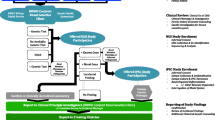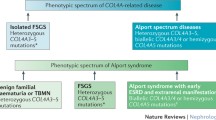Abstract
A recent review identified 60 common inherited renal diseases caused by DNA variants in 132 different genes. These diseases can be diagnosed with DNA sequencing, but each gene probably also has a thousand normal variants. Many more normal variants have been characterised by individual laboratories than are reported in the literature or found in publicly accessible collections. At present, testing laboratories must assess each novel change they identify for pathogenicity, even when this has been done elsewhere previously, and the distinction between normal and disease-associated variants is particularly an issue with the recent surge in exomic sequencing and gene discovery projects. The Human Variome Project recommends the establishment of gene-specific DNA variant databases to facilitate the sharing of DNA variants and decisions about likely disease causation. Databases improve diagnostic accuracy and testing efficiency, and reduce costs. They also help with genotype–phenotype correlations and predictive algorithms. The Human Variome Project advocates databases that use standardised descriptions, are up-to-date, include clinical information and are freely available. Currently, the genes affected in the most common inherited renal diseases correspond to 350 different variant databases, many of which are incomplete or have insufficient clinical details for genotype–phenotype correlations. Assistance is needed from nephrologists to maximise the usefulness of these databases for the diagnosis and management of inherited renal disease.
Similar content being viewed by others
References
Hildebrandt F (2010) Genetic kidney diseases. Lancet 375:1287–1295
Abecasis GR, Altshuler D, Auton A, Brooks LD, Durbin RM, Gibbs RA, Hurles ME, McVean GA (2010) A map of human genome variation from population-scale sequencing. Nature 467:1061–1073
Yang Y, Muzny DM, Reid JG, Bainbridge MN, Willis A, Ward PA, Braxton A, Beuten J, Xia F, Niu Z, Hardison M, Person R, Bekheirnia MR, Leduc MS, Kirby A, Pham P, Scull J, Wang M, Ding Y, Plon SE, Lupski JR, Beaudet AL, Gibbs RA, Eng CM (2013) Clinical whole-exome sequencing for the diagnosis of mendelian disorders. N Engl J Med 369:1502–1511
Celli J, Dalgleish R, Vihinen M, Taschner PE, den Dunnen JT (2012) Curating gene variant databases (LSDBs): toward a universal standard. Hum Mutat 33:291–297
Cotton RG, Auerbach AD, Beckmann JS, Blumenfeld OO, Brookes AJ, Brown AF, Carrera P, Cox DW, Gottlieb B, Greenblatt MS, Hilbert P, Lehvaslaiho H, Liang P, Marsh S, Nebert DW, Povey S, Rossetti S, Scriver CR, Summar M, Tolan DR, Verma IC, Vihinen M, den Dunnen JT (2008) Recommendations for locus-specific databases and their curation. Hum Mutat 29:2–5
Vihinen M, den Dunnen JT, Dalgleish R, Cotton RG (2012) Guidelines for establishing locus specific databases. Hum Mutat 33:298–305
Fokkema IF, Taschner PE, Schaafsma GC, Celli J, Laros JF, den Dunnen JT (2011) LOVD v. 2.0: the next generation in gene variant databases. Hum Mutat 32:557–563
Fokkema IF, den Dunnen JT, Taschner PE (2005) LOVD: easy creation of a locus-specific sequence variation database using an “LSDB-in-a-box” approach. Hum Mutat 26:63–68
Wildeman M, van Ophuizen E, den Dunnen JT, Taschner PE (2008) Improving sequence variant descriptions in mutation databases and literature using the Mutalyzer sequence variation nomenclature checker. Hum Mutat 29:6–13
Den Dunnen JT, Antonarakis SE (2000) Mutation nomenclature extensions and suggestions to describe complex mutations: a discussion. Hum Mutat 15:7–12
Wain HM, Bruford EA, Lovering RC, Lush MJ, Wright MW, Povey S (2002) Guidelines for human gene nomenclature. Genomics 79:464–470
Smith CI, Vihinen M (1996) Immunodeficiency mutation databases—a new research tool. Immunol Today 17:495–496
Dalgleish R, Flicek P, Cunningham F, Astashyn A, Tully RE, Proctor G, Chen Y, McLaren WM, Larsson P, Vaughan BW, Beroud C, Dobson G, Lehvaslaiho H, Taschner PE, den Dunnen JT, Devereau A, Birney E, Brookes AJ, Maglott DR (2010) Locus reference genomic sequences: an improved basis for describing human DNA variants. Genome Med 2:24
Benson DA, Karsch-Mizrachi I, Clark K, Lipman DJ, Ostell J, Sayers EW (2012) Genbank. Nucleic Acids Res 40:D48–53
Claustres M, Horaitis O, Vanevski M, Cotton RG (2002) Time for a unified system of mutation description and reporting: a review of locus-specific mutation databases. Genome Res 12:680–688
Mitropoulou C, Webb AJ, Mitropoulos K, Brookes AJ, Patrinos GP (2010) Locus-specific database domain and data content analysis: evolution and content maturation toward clinical use. Hum Mutat 31:1109–1116
Robinson PN, Mundlos S (2010) The human phenotype ontology. Clin Genet 77:525–534
Povey S, Al Aqeel AI, Cambon-Thomsen A, Dalgleish R, den Dunnen JT, Firth HV, Greenblatt MS, Barash CI, Parker M, Patrinos GP, Savige J, Sobrido MJ, Winship I, Cotton RG (2010) Practical guidelines addressing ethical issues pertaining to the curation of human locus-specific variation databases (LSDBs). Hum Mutat 31:1179–1184
Tavtigian SV, Greenblatt MS, Goldgar DE, Boffetta P (2008) Assessing pathogenicity: overview of results from the IARC unclassified genetic variants working group. Hum Mutat 29:1261–1264
Thorisson GA (2009) Accreditation and attribution in data sharing. Nat Biotechnol 27:984–985
Giardine B, Borg J, Higgs DR, Peterson KR, Philipsen S, Maglott D, Singleton BK, Anstee DJ, Basak AN, Clark B, Costa FC, Faustino P, Fedosyuk H, Felice AE, Francina A, Galanello R, Gallivan MV, Georgitsi M, Gibbons RJ, Giordano PC, Harteveld CL, Hoyer JD, Jarvis M, Joly P, Kanavakis E, Kollia P, Menzel S, Miller W, Moradkhani K, Old J, Papachatzopoulou A, Papadakis MN, Papadopoulos P, Pavlovic S, Perseu L, Radmilovic M, Riemer C, Satta S, Schrijver I, Stojiljkovic M, Thein SL, Traeger-Synodinos J, Tully R, Wada T, Waye JS, Wiemann C, Zukic B, Chui DH, Wajcman H, Hardison RC, Patrinos GP (2011) Systematic documentation and analysis of human genetic variation in hemoglobinopathies using the microattribution approach. Nat Genet 43:295–301
Gout AM, Ravine D, Harris PC, Rossetti S, Peters D, Breuning M, Henske EP, Koizumi A, Inoue S, Shimizu Y, Thongnoppakhun W, Yenchitsomanus PT, Deltas C, Sandford R, Torra R, Turco AE, Jeffery S, Fontes M, Somlo S, Furu LM, Smulders YM, Mercier B, Ferec C, Burtey S, Pei Y, Kalaydjieva L, Bogdanova N, McCluskey M, Geon LJ, Wouters CH, Reiterova J, Stekrova J, San Millan JL, Aguiari G, Del Senno L (2007) Analysis of published PKD1 gene sequence variants. Nat Genet 39:427–428
Murphy JA, Barrantes-Reynolds R, Kocherlakota R, Bond JP, Greenblatt MS (2004) The CDKN2A database: Integrating allelic variants with evolution, structure, function, and disease association. Hum Mutat 24:296–304
Savige J, Dagher H, Povey S (2014) Mutation databases for inherited renal disease: are they complete, accurate, clinically relevant, and freely available? Hum Mutat 35:791–793
Gout AM, Martin NC, Brown AF, Ravine D (2007) PKDB: Polycystic Kidney Disease Mutation Database—a gene variant database for autosomal dominant polycystic kidney disease. Hum Mutat 28:654–659
International Alport Mutation Consortium, Savige J, Ars E, Cotton RG, Crockett D, Dagher H, Deltas C, Ding J, Flinter F, Pont-Kingdon G, Smaoui N, Torra R, Storey H (2014) DNA variant databases improve test accuracy and phenotype prediction in Alport syndrome. Pediatr Nephrol 29:971–977
Crockett DK, Pont-Kingdon G, Gedge F, Sumner K, Seamons R, Lyon E (2010) The Alport syndrome COL4A5 variant database. Hum Mutat 31:E1652–1657
Hoogeveen-Westerveld M, Wentink M, van den Heuvel D, Mozaffari M, Ekong R, Povey S, den Dunnen JT, Metcalfe K, Vallee S, Krueger S, Bergoffen J, Shashi V, Elmslie F, Kwiatkowski D, Sampson J, Vidales C, Dzarir J, Garcia-Planells J, Dies K, Maat-Kievit A, van den Ouweland A, Halley D, Nellist M (2011) Functional assessment of variants in the TSC1 and TSC2 genes identified in individuals with tuberous sclerosis complex. Hum Mutat 32:424–435
ACMG Board of Directors (2012) Points to consider in the clinical application of genomic sequencing. Genet Med 14:759–761
Maddalena A, Bale S, Das S, Grody W, Richards S (2005) Technical standards and guidelines: molecular genetic testing for ultra-rare disorders. Genet Med 7:571–583
Cotton RG, Auerbach AD, Brown AF, Carrera P, Christodoulou J, Claustres M, Compton J, Cox DW, De Baere E, den Dunnen JT, Greenblatt M, Fujiwara M, Hilbert P, Jani A, Lehvaslaiho H, Nebert DW, Verma I, Vihinen M (2007) A structured simple form for ordering genetic tests is needed to ensure coupling of clinical detail (phenotype) with DNA variants (genotype) to ensure utility in publication and databases. Hum Mutat 28:931–932
Haworth A, Bertram L, Carrera P, Elson JL, Braastad CD, Cox DW, Cruts M, den Dunnen JT, Farrer MJ, Fink JK, Hamed SA, Houlden H, Johnson DR, Nuytemans K, Palau F, Rayan DL, Robinson PN, Salas A, Schule B, Sweeney MG, Woods MO, Amigo J, Cotton RG, Sobrido MJ (2011) Call for participation in the neurogenetics consortium within the Human Variome Project. Neurogenetics 12:169–173
Den Dunnen JT, Sijmons RH, Andersen PS, Vihinen M, Beckmann JS, Rossetti S, Talbot CC Jr, Hardison RC, Povey S, Cotton RG (2009) Sharing data between LSDBs and central repositories. Hum Mutat 30:493–495
Acknowledgements
The authors of this manuscript are all members of the Human Variome Project, but have no financial disclosures or conflicts of interest to declare. The research leading to these results has received funding from the European Community’s Seventh Framework Programme (FP7/2007-2013) under grant agreement number 200754—the GEN2PHEN project. This funding source played no role in the production of this manuscript. This work was completed while JS was a Visiting Academic within the Research Department of Genetics, Evolution and the Environment at University College London.
Author information
Authors and Affiliations
Corresponding author
Rights and permissions
About this article
Cite this article
Savige, J., Dalgleish, R., Cotton, R.G. et al. The Human Variome Project: ensuring the quality of DNA variant databases in inherited renal disease. Pediatr Nephrol 30, 1893–1901 (2015). https://doi.org/10.1007/s00467-014-2994-1
Received:
Revised:
Accepted:
Published:
Issue Date:
DOI: https://doi.org/10.1007/s00467-014-2994-1




